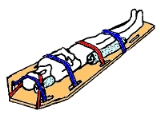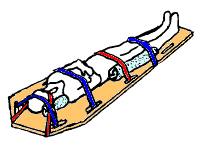
Long spine board
Encyclopedia

Patient
A patient is any recipient of healthcare services. The patient is most often ill or injured and in need of treatment by a physician, advanced practice registered nurse, veterinarian, or other health care provider....
handling device used primarily in pre-hospital trauma
Trauma (medicine)
Trauma refers to "a body wound or shock produced by sudden physical injury, as from violence or accident." It can also be described as "a physical wound or injury, such as a fracture or blow." Major trauma can result in secondary complications such as circulatory shock, respiratory failure and death...
care designed to provide rigid support during movement of a patient with suspected spinal or limb injuries. They are most commonly used by ambulance
Ambulance
An ambulance is a vehicle for transportation of sick or injured people to, from or between places of treatment for an illness or injury, and in some instances will also provide out of hospital medical care to the patient...
services, by staff such as emergency medical technician
Emergency medical technician
Emergency Medical Technician or Ambulance Technician are terms used in some countries to denote a healthcare provider of emergency medical services...
s and paramedic
Paramedic
A paramedic is a healthcare professional that works in emergency medical situations. Paramedics provide advanced levels of care for medical emergencies and trauma. The majority of paramedics are based in the field in ambulances, emergency response vehicles, or in specialist mobile units such as...
s, but are also used by specialist emergency personnel such as lifeguards.
Indications for use
A spinal board is primarily indicated for use in cases of trauma where the medical or rescue personnel believe that there is a possibility of spinal injury, usually due to mechanism of injury, and the attending team are not able to rule out a spinal injuryClearing the cervical spine
Clearing the cervical spine is the process by which medical professionals determine whether cervical spine injuries exist. This process can take place in the emergency department or take place in the field by appropriately trained EMS personnel. The following is based on the NEXUS criteria...
. Due to the problems associated with extended use, it is designed primarily as an extrication
Vehicle extrication
Vehicle extrication is the process of removing the vehicle from around a person that has been involved in a motor vehicle accident, when conventional means of exit are impossible or unadvisable. A delicate approach is needed to minimize injury to the victim during the extrication...
device, especially from vehicles.
Backboards are almost always used in conjunction with the following devices:
- a cervical collarCervical collarA cervical collar is an orthopedic medical device used to support a patient's neck and head. It is also used by emergency personnel for victims of traumatic head or neck injuries, and can be used to treat chronic medical conditions....
with occipital padding as needed; - side head supports, such as a rolled blanket or head blocks made specifically for this purpose, used to avoid the lateral rotation of the head;
- straps to secure the patient to the long spine board, and tape to secure the head
Construction
Spine boards are typically made of wood or plastic, although there has been a strong shift away from wood boards due to their higher level of maintenance required to keep them in operable condition and to protect them from cracks and other imperfections that could harbour bacteria.Backboards are designed to be slightly wider and longer than the average human body to accommodate the immobilization straps, and have handles for carrying the patient. Most backboards are designed to be completely X-ray
X-ray
X-radiation is a form of electromagnetic radiation. X-rays have a wavelength in the range of 0.01 to 10 nanometers, corresponding to frequencies in the range 30 petahertz to 30 exahertz and energies in the range 120 eV to 120 keV. They are shorter in wavelength than UV rays and longer than gamma...
translucent so that they do not interfere with the exam while patients are strapped to them. They are light enough to be easily carried by one person, and are usually buoyant.
Clinical issues
Common clinical issues found with spinal boards include pressure sore development, inadequacy of spinal immobilisation, pain and discomfort, respiratory compromise and affects on the quality of radiological imaging. For this reason, some professionals view them as unsuitable for the task, preferring alternatives.It is advised that no patient should spend more than 30 minutes on a spine board, due to the development of discomfort and pressure sores.
Alternatives
The primary alternative, now considered gold standard for trauma care, is the vacuum mattressVacuum mattress
A vacuum mattress, or vacmat, is a medical device used for the immobilisation of patients, especially in case of a vertebra, pelvis or limb trauma . It is also used for manual transportation of patients for short distances...
, which is flexible when soft, but it hardened through evacuation of air. The conforming nature of the vacuum mattress means that patients can be kept immobilised on it for longer periods of time and the immobilisation offers superior stability and comfort to the patient.
There are also short spine boards, but the short spine board is rarely used now due to the presence of superior devices, such as the Kendrick Extrication Device.

